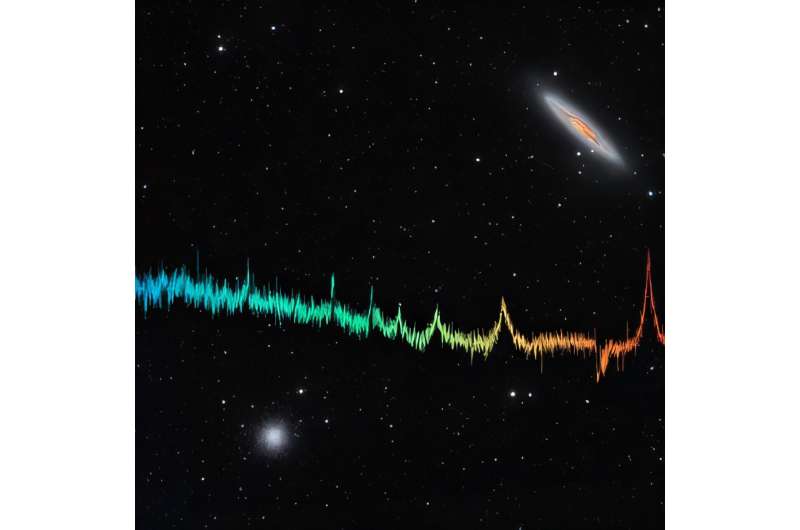Science
4MOST Telescope Achieves First Light, Paving Way for Cosmic Discoveries

On October 18, 2025, the 4-meter Multi-Object Spectroscopic Telescope (4MOST) at the European Southern Observatory’s (ESO) Paranal Observatory in Chile successfully captured its first light. This significant milestone signals the telescope’s readiness to embark on its scientific mission, which includes unraveling the mysteries of the universe.
4MOST is not merely a traditional telescope; it has the ability to record the spectra of celestial objects, allowing astronomers to dissect the light into its constituent colors. This capability enables the facility to analyze light from up to 2,400 objects simultaneously, breaking it down into 18,000 color components. Such detailed analysis will facilitate investigations into various cosmic phenomena, including the formation and evolution of stars and galaxies, the nature of black holes, and the broader universe.
With the potential to catalogue the temperatures, chemical compositions, velocities, and other physical properties of tens of millions of objects across the Southern sky, 4MOST is set to become the largest multi-object spectroscopic survey facility in the hemisphere. The facility is designed for a minimum operational period of 15 years, having undergone development since 2010.
Innovative Design and Scientific Goals
The Leibniz Institute for Astrophysics Potsdam (AIP) leads the 4MOST Consortium, which has played a crucial role in the telescope’s development and scientific operations. AIP has contributed significantly to various components, including the wide field camera, guiding and focusing systems, and an advanced fiber system that incorporates over 2,400 optical fibers, each comparable in size to a human hair.
4MOST’s Principal Investigator, Roelof de Jong, expressed his enthusiasm about the first spectra obtained, stating, “It is incredible to see the first spectra from our new instrument… That we can catch the light that has sometimes traveled for billions of light years into a glass fiber the size of a hair is mind-boggling.” The project’s success relies on the collaborative efforts of over 700 scientists from various institutions worldwide.
The telescope’s first light observations highlighted the elongated galaxy NGC 253, known as the Sculptor or Silver Coin galaxy. This galaxy, nearly the same apparent diameter as the moon, is located approximately 11.5 million light years from Earth and is active in forming new stars. Observations also included a super star cluster and various stars within NGC 253, along with the globular cluster NGC 288, which contains around 100,000 ancient stars situated about 30,000 light years from Earth.
Expanding the Universe of Knowledge
4MOST will observe new sets of objects every 10–20 minutes, utilizing a fiber positioner that can reposition fibers to capture new targets in under two minutes. The telescope’s three spectrographs can simultaneously analyze 800 objects, breaking their light into red, green, and blue components, and further detailing it for analysis.
During its initial five years of operation, 4MOST is set to implement 25 different science programs. Among these, ten were designed by the consortium, while the remaining fifteen were selected by an external committee of astronomers. The telescope’s unique multi-fiber capability allows for simultaneous observations of disparate scientific interests.
Highlighted scientific objectives include investigating the origins of chemical elements, the growth of the Milky Way, the formation of galaxies and black holes, and the nature of dark matter and dark energy that influence cosmic expansion.
The data collected will be processed at the 4MOST data center at the University of Cambridge, where extensive software pipelines will extract physical parameters of the observed objects. The results will then be archived and made accessible to the scientific community for further exploration.
As 4MOST begins its journey into the cosmos, it stands poised to offer unprecedented insights into the universe, shaping our understanding of fundamental astronomical questions for years to come.
-

 Lifestyle3 months ago
Lifestyle3 months agoLibraries Challenge Rising E-Book Costs Amid Growing Demand
-

 Sports3 months ago
Sports3 months agoTyreek Hill Responds to Tua Tagovailoa’s Comments on Team Dynamics
-

 Sports3 months ago
Sports3 months agoLiverpool Secures Agreement to Sign Young Striker Will Wright
-

 Lifestyle3 months ago
Lifestyle3 months agoSave Your Split Tomatoes: Expert Tips for Gardeners
-

 Lifestyle3 months ago
Lifestyle3 months agoPrincess Beatrice’s Daughter Athena Joins Siblings at London Parade
-

 World3 months ago
World3 months agoWinter Storms Lash New South Wales with Snow, Flood Risks
-

 Science3 months ago
Science3 months agoTrump Administration Moves to Repeal Key Climate Regulation
-

 Business3 months ago
Business3 months agoSoFi Technologies Shares Slip 2% Following Insider Stock Sale
-

 Science2 months ago
Science2 months agoSan Francisco Hosts Unique Contest to Identify “Performative Males”
-

 Science3 months ago
Science3 months agoNew Tool Reveals Link Between Horse Coat Condition and Parasites
-

 Sports3 months ago
Sports3 months agoElon Musk Sculpture Travels From Utah to Yosemite National Park
-

 Science3 months ago
Science3 months agoNew Study Confirms Humans Transported Stonehenge Bluestones









